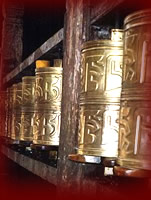 |
chokhor Tibetan prayer wheels |
There are four major Tibetan Buddhist holidays—duchen or ‘great occasions’—marking the four events known as the ‘great deeds’ of the Buddha. The first is Chotrul Duchen, which falls on the first full moon of the year and celebrates the time when the Buddha is said to have displayed a different miracle each day to spur on his disciples. The next is Saga Dawa, which remembers the Buddha’s enlightenment, death and parinirvana. And the third is Chokhor Duchen, which commemorates the Buddha’s first sermon and the teaching of the Four Noble Truths.*
In Buddhism this event is known as the ‘turning of the wheel of dharma’. Theravadin Buddhists remember this event on Dhamma Day**, also known as Asalha Puja, in reference to the month in which it occurs. In Tibet it is a day of pilgrimage when believers visit particularly holy spots to leave offerings of incense and prayer flags. The whole community, cleric and lay people alike, join in processions bearing statues of the Buddha and copies of the scriptures.
Chokhor or prayer wheels are common religious objects in Tibet, part of daily life for both Buddhists and followers of the native Bon religion. Hand held wheels are hollow wooden or metal cylinders attached to a handle which when turned are believed to spread spiritual blessing. Mantras—such as Om Mani Padme Hum, believed to invoke the attention and blessings of Chenrezig, the Buddha of compassion—may be printed or etched on the cylinder, each revolution said to equal one repetition. Larger prayer wheels, such as those in the illustration above, may be lined up on racks along paths circling monasteries or other sites so that passing pilgrims can set them into motion.
*The
fourth festival is Lhabab Duchen, which commemorates the Buddha’s
descent from the heavenly realm following his visit there to teach his
deceased mother.
**Sanskrit, dharma, Pali, dhamma.